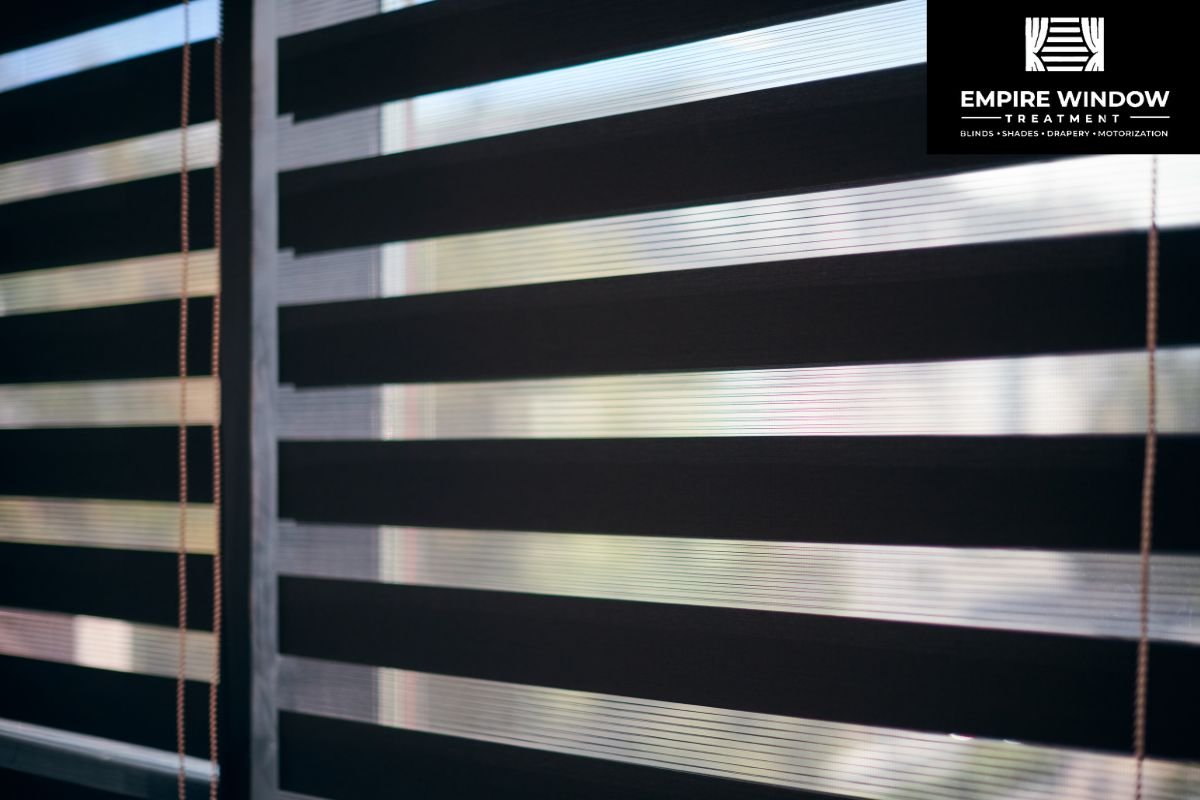Key Takeaways
- Blackout blinds block nearly all light, ideal for better sleep, privacy, and energy savings.
- Top types include cellular, roller, Roman, paper shades, and track-fitted blinds for full darkness.
- Fit and material are critical—look for thick, opaque fabrics and tight window coverage to stop light leaks.
- For total blackout, use side tracks, outside mounts, or layer with blackout curtains.
What Are Blackout Blinds?
Blackout blinds are special window coverings that are designed to block out nearly all light from coming into a room. Think of them like a superhero shield for your windows! They are made from thick materials that light can’t easily pass through, and they are often designed to fit very snugly against your window frames to stop light from sneaking in around the edges.
People use blackout blinds for many reasons. Sometimes, they want to make a bedroom super dark for sleeping, especially during the day. Other times, they use them in a TV room to get rid of glare on the screen, making movie nights much better. They’re also great for privacy, so no one can see into your home, and they can even help keep your room cooler in the summer and warmer in the winter, saving you energy.
Main Types of Blackout Blinds
When you’re looking for blackout blinds, you’ll find a few main types, each with its own special features.
Cellular (Honeycomb) Blinds
These blinds have a unique design that looks like honeycombs when you look at them from the side. This shape traps air, which helps block light and also acts like insulation, keeping your room warmer in winter and cooler in summer. They’re a top choice for bedrooms and nurseries because they are so effective at blocking light and also help with temperature control.
Roller Shades
These are one of the most popular types. They are made from a single piece of thick fabric that rolls up neatly into a tube at the top of your window. When you pull them down, the thick material does a great job of blocking light. Roller shades are simple to use and come in many colors and patterns, making them good for almost any room in your house.
Roman Blinds
Roman blinds are made from fabric that folds up in soft, elegant pleats when you raise them. To make them blackout, they have a special blackout lining sewn onto the back. This lining stops light, while the front fabric adds a stylish look to your room. They are often chosen for living rooms or bedrooms where you want a mix of light control and decorative style.
Blackout Blinds with Tracks (Side Channels)
These are the champions of total darkness! These blinds have special channels or “tracks” that run down the sides of your window frame. The blind fabric fits into these tracks, which stops any light from leaking in around the edges. If you need a room to be as dark as possible, like a home theater or a baby’s nursery where even a tiny bit of light is a problem, these blinds are the best option.
Temporary Paper Shades
If you need a quick and easy solution, temporary paper shades are a great choice. They are usually made from thick paper or a similar material, and they often have an adhesive strip so you can stick them directly onto your window frame. They are affordable and easy to put up, making them perfect for dorm rooms, rental apartments, or even when you’re traveling and need a dark room. They’re also good if you’re waiting for your permanent blinds to arrive.
What to Look For When Choosing Blackout Blinds
To make sure you pick the best blackout blinds, here are a few important things to keep in mind.
First, always look for blinds made from thick, opaque materials. “Opaque” means that light cannot pass through it at all. The thicker and denser the fabric or material, the better it will be at blocking light. Hold a sample up to a light source to test it if you can.
Second, the fit of the blinds is super important. Even the thickest material won’t work perfectly if there are gaps around the edges where light can sneak in. Make sure you measure your windows very carefully so your blinds fit snugly inside or completely cover your window frame. Some blinds even come with side channels or tracks that help seal out light at the edges.
Third, consider cordless or motorized options for safety. If you have kids or pets, cordless blinds are a safer choice because there are no hanging cords that could be a hazard. Motorized blinds are super convenient because you can open and close them with a remote control or even an app on your phone.
Finally, think about how the blinds will match the size and style of your room. You want them to look good and fit well. Also, consider how easy they will be to clean and maintain. Some materials are simple to wipe down, while others might need more careful cleaning.
Blackout Blinds vs. Blackout Curtains: Which is Better?
Both blackout blinds and blackout curtains are great for blocking light, but they have some differences.
| Feature | Blackout Blinds | Blackout Curtains |
| Light Blocking | Excellent, especially with a good fit and side tracks | Excellent, if they are very thick and wide enough |
| Space Saver | Yes, they fit neatly inside or close to the window | No, they take up more room and can look bulky |
| Easy to Adjust | Yes, usually simple to raise or lower | Sometimes harder, you often have to open or close them fully |
| Insulation | Good (cellular blinds are best for this) | Great (heavy fabrics provide good insulation) |
| Cleaning | Easier, often just dusting or spot cleaning | Sometimes harder, might need machine washing or dry cleaning |
Blackout blinds often provide a more complete seal against light, especially if they have side tracks. They also take up less space and can look very neat and modern. Blackout curtains, on the other hand, can add more warmth and texture to a room, and heavy curtains can offer even better soundproofing. For the very best light blocking, using both together is a winning combination!

Benefits of Blackout Blinds
Blackout blinds offer several great advantages for your home. One of the biggest benefits is that they help you get better sleep. If your room is too bright, especially in the morning or if you work at night and need to sleep during the day, blackout blinds can create the perfect dark environment for deep, restful sleep.
They also give you more privacy. With blackout blinds, you don’t have to worry about people seeing into your home, which can make you feel safer and more comfortable. Plus, they can make watching TV or using your computer much easier by cutting down on annoying glare.
Finally, because they’re so good at blocking light and heat, they can help keep your room at a comfortable temperature, which might even lower your energy bills.
How to Prevent Light Leaks and Get True Blackout
Even with great blackout blinds, you might notice tiny bits of light still peeking through. This often happens around the edges of the blinds. Here’s how to get as close to true blackout as possible:
- Use side channels or tracks: As mentioned before, some blackout blinds come with U-shaped tracks that you install on the sides of your window frame. The blind fabric runs inside these tracks, creating a tight seal that blocks all light from escaping around the sides. This is one of the most effective ways to achieve total darkness.
- Mount blinds outside the window frame (Outside Mount): If you install your blinds on the wall above and around your window frame instead of inside it, you can choose blinds that are a few inches wider and longer than your actual window. This allows the blind to overlap the window opening completely, which helps prevent light from leaking in at the edges. This is often better than an “inside mount” for maximum blackout.
- Add blackout curtains as a second layer: For the ultimate light blockage, combine your blackout blinds with blackout curtains. The blinds will handle most of the light, and the curtains can cover any tiny gaps or light leaks from the sides or top. This also adds an extra layer of insulation and can look very stylish.
Recommended Blackout Blind Brands or Top Picks
When you’re ready to buy, it helps to know some reliable options. Here are a few popular types of blackout blinds that get good reviews:
- Select Blinds Classic Blackout Roller Shades: These are known for being effective and easy to use, with a good range of colors.
- IKEA Trippelvåls Cellular Blinds: If you like the honeycomb style, these are a popular and affordable option from IKEA, often praised for their light-blocking abilities.
- iFit Cordless Blackout Roller Shades: Cordless options are great for safety and a clean look, and brands like iFit offer good blackout features.
- Redi Shade Original Blackout Paper Shades: These are temporary, stick-on shades that are perfect for a quick fix or when you’re on a budget.
Always read reviews and check the product descriptions to make sure the specific blinds you choose meet your blackout needs and fit your window measurements.
Frequently Asked Questions About Blackout Blinds
You might have some more questions about blackout blinds. Here are answers to some common ones:
Are blackout blinds safe for kids?
Yes, especially if you choose cordless or motorized options. These types don’t have dangling cords, which can be a hazard for small children and pets. Always look for “cordless” or “child-safe” features if you have little ones.
Can blackout blinds help reduce noise?
Yes, they can! Because blackout blinds are made from thick materials, they can help absorb some sound. While they won’t block all noise like a soundproof wall, they can definitely make your room a bit quieter, especially if you get thicker options like cellular blinds or combine them with heavy curtains.
Do blackout blinds save energy?
Absolutely! Their thick material acts as an extra layer of insulation for your windows. This means they can help keep your room cooler by blocking out hot sunlight in the summer and keep it warmer by preventing heat from escaping through the windows in the winter. This can lead to lower heating and cooling bills.
Tips for Cleaning and Maintaining Blackout Blinds
Keeping your blackout blinds clean will help them last longer and look good.
- Dust or vacuum regularly: The easiest way to keep them clean is to dust them often with a feather duster or a soft cloth. For a deeper clean, you can use the brush attachment on your vacuum cleaner to gently vacuum away dust and dirt.
- Spot clean stains with mild soap and water: If you get a small spot or stain, use a clean cloth dampened with a little bit of mild soap (like dish soap) and water. Gently blot the stain until it’s gone. Avoid rubbing too hard, which can damage the fabric. Always test a small, hidden area first to make sure the cleaning solution doesn’t discolor the material.
- Never use harsh cleaners or bleach: Strong chemicals can damage the blackout material or fade the color of your blinds. Stick to mild soap and water for most cleaning tasks.
Conclusion
Choosing the best blackout blinds means thinking about what you need most. First, decide which type of blind works best for your room do you want roller shades for simplicity, cellular for insulation, or Roman for style?
Second, measure your windows carefully to ensure you get a snug fit that blocks out as much light as possible. Remember, a good fit is key to true darkness.
Third, think about the material and how much light it blocks. The thicker and more opaque, the better for blackout.
Finally, consider whether you need the room to be totally dark (like for a home theater or nursery) or just very dim. For total darkness, look for blinds with side tracks or consider adding blackout curtains. By keeping these points in mind, you can pick the perfect blackout blinds to help you get better sleep, more privacy, and a more comfortable home.

